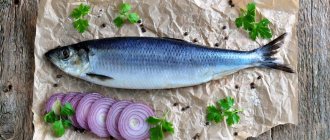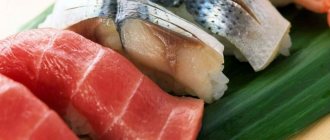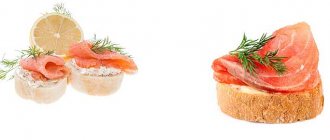Belonging to the salmon family, trout is considered one of the most exquisite varieties of fish. Known for its excellent taste, as well as beneficial properties, it, unfortunately, rarely appears on the tables of ordinary citizens due to its very high price. Nowadays it is mainly bought only on holidays as a delicacy, but despite this, in reality, trout is excellent for the everyday diet. This article will talk about the benefits and harms of trout for the human body.
Features of trout
Before talking about the benefits and harms of trout, you should find out what this fish is. As mentioned earlier, it belongs to the salmon family, which includes a wide variety of species. However, they all have one common feature - they can only live in clean and cold waters, and therefore the quality of trout is usually very high.
In appearance, trout is a fish with an elongated body that is slightly compressed at the sides. Its scales are usually very small and slightly shiny. Its color depends on the color of the water in which the trout lives. Depending on the species, it can have a different size, although its standard weight does not exceed 1 kg and its length is 50 cm. Male trout are usually larger than females and also have a larger head.
Trout - what kind of fish is it?
The name “Trout” is given to several species of fish from the salmon family. They have some common features:
- Short and truncated muzzle.
- The fins contain an equal number of rays, which are unlike other salmonids.
- This species has a special arrangement of teeth.
- And other signs that only specialists can identify.
This type of fish lives in completely different conditions, which is why they have different colors . The color of their body has camouflage functions and changes depending on the environment in which they live. If an individual recently swam from the sea, then it has a silvery tint, while lake inhabitants have brighter colors on their bodies. The sides are usually yellow, the back has an olive tint.
The spots on the body are gray, black, white, and also red. There are individuals with a uniformly dark color. And sometimes these fish are very light. Their colors change depending on the time of year, the color of the bottom of the reservoir, and food.
This red fish can be prepared in a variety of ways: boiled, fried, baked, and so on. This fish contains many useful microelements and vitamins.
Energy value
Almost all the health benefits and harms of trout depend on its nutritional value. The large amount of omega-3 fatty acids, vitamins, microelements and amino acids it contains gives the fish an incredibly refined taste, and also helps provide the human body with all the beneficial substances it needs.
In addition, this fish has a relatively low calorie content - only 88 kcal per 100 grams, so even those who want to lose weight or adhere to a healthy diet can safely consume it.
Selection of fish
Trout is a fairly expensive fish, and therefore it is very important when going to the store to choose the highest quality and freshest product in order to get a large amount of useful substances. When purchasing, be sure to pay attention to:
- The color and elasticity of the skin, as well as the overall presentation. Slippery and elastic skin indicates the freshness of the fish. However, if the fish looks unnaturally bright, this may indicate that the sellers specially processed it.
- Cloudiness in the eyes - its presence hints that the fish has been lying there for a long time.
- The color of the gills should be pinkish; if they are dark brown, it means the fish is not fresh.
The importance of Omega-3 for women
After numerous studies, it was found that eating large amounts of fatty sea fish
significantly reduces the risk of certain diseases. Healthy fats are found in tuna, mackerel, salmon, trout and herring. The amount of useful substance depends on the method of their preparation; it is recommended to use boiled and lightly salted fish. Omega-3 is also found in eggs, vegetable oil and meat.
Women's diet can be designed in such a way that sea fish is rarely present on the table, then it is worth purchasing Omega-3 pharmaceutical supplements. They are taken in the range of 3 - 5 grams per day
. Above this dosage, the use of supplements should be agreed with a doctor.
Beneficial features
When considering the benefits and harms of trout for the body, the first thing to mention is its beneficial qualities. This fish should definitely be included in the diet, if only because the amount of nutrients it contains can almost completely provide the daily requirement for the human body.
In addition, constant consumption of this fish improves brain function and increases activity, helping to quickly cope with any signs of fatigue and drowsiness.
Omega-3 fatty acids, which are found in large quantities in trout, also have a positive effect on the functioning of the brain, as well as the central nervous system, suppressing signs of depression and stress. This substance also helps remove bad cholesterol from the blood and improve the functioning of the cardiovascular system, which is useful for preventing a heart attack or the development of other diseases.
The beneficial properties of trout also include the prevention of many dangerous diseases. It was found that people who regularly consume this fish have a lower risk of developing cancer, atherosclerosis, high blood pressure, diabetes and depression.
As mentioned earlier, trout is also a low-calorie product, and therefore can be consumed even by those who are careful about the amount of calories they consume. In addition, it is quickly digested in the stomach, and therefore beneficial substances quickly enter the bloodstream. It can be consumed even by children and allergy sufferers, since this fish is a hypoallergenic variety.
Pregnant and lactating
Fish may contain mercury, so it is recommended to consume it with caution during pregnancy. However, trout meat has a low concentration of this substance. If you are not allergic to fish, doctors allow it to be included in your diet.
It helps maintain normal weight, provides the body with substances beneficial for fetal development, reduces the risk of anemia, and improves digestion. The recommended dose is no more than 300 g once every 2 days. Pregnant women should eat boiled, steamed and baked fish.
When breastfeeding, trout should be avoided; its components penetrate into the milk and can cause allergies in the baby. The mother should choose low-fat varieties of sea fish with white meat.
Harmful properties
Trout is not only beneficial, but also harmful to the body, so when introducing it into the diet, all contraindications must be taken into account. First of all, it should be used very carefully during pregnancy and lactation, since fish often contains mercury. And if the proportion of the substance that is in it is tiny for an adult and cannot harm him, then it can affect a child very negatively.
People with ulcers in the gastrointestinal tract and liver disorders should also be very careful about this fish, since the saturated fats it contains increase the level of functioning of the digestive system. It would also be better not to use trout heads when preparing dishes, since it is in them that toxic substances from the reservoirs in which the trout lived accumulate.
RECIPE FOR LIGHT SALTED TROUT
To prepare lightly salted trout you will need the following ingredients:
- trout – 1.5 kg
- salt - 200 g
- sugar - 100 g
- water - 1000 g
- bay leaf 4 - 5 pcs
- allspice peas - 10 pcs
PREPARATION PROCEDURE:
1. Cook the brine to pour the trout. To do this, pour 1 liter of water into a saucepan, add salt, sugar, bay leaf, and sweet peas. Bring to a boil (until salt and sugar are completely dissolved).
2. Let the brine cool.
3. Clean the trout. We transfer it to a bowl in which it will be salted (it is advisable that there is little free space so that the brine then completely covers the fish).
4. Fill the fish with brine.
5. Put it in the refrigerator. We keep her there for a day.
You can try it in a day.
Remove the fish from the brine, wrap it in tracing paper and put it in a plastic bag in the refrigerator or in a container.
Enjoy your meal.
sea trout
Now let's talk directly about the benefits and harms of sea trout, as well as its differences from all other varieties. Such fish are considered the most valuable catch for fishermen, since they are very difficult to catch. Its meat is redder in color than all other varieties. Females are usually larger than males, and the fish itself may be larger than its relatives from other habitats. In size it can reach from 50 cm to 1 m, and in weight individuals up to 25 kg have been found, although they rarely actually grow that large.
The meat of this type of trout is fattier and tastier than other varieties, it contains a large amount of vitamins and amino acids, and is also higher in calories. Its frequent use has a positive effect on metabolism, lowers cholesterol, and also helps fight depression and improves memory. It is often recommended for restoring protein and fat metabolism, as well as preventing cancer.
Rainbow trout
One of the most common species that is actively targeted by anglers is the rainbow trout. The benefits and harms of this species, which lives in ponds and lakes, are practically no different from all other varieties. Its standard dimensions are 40-50 cm in length, and its weight is about two kilograms. A special feature is the light shades of the scales, which are almost invisible on the bottom of the lake, which has led to the fact that this fish is often called white trout.
The meat of rainbow trout is light pink, and it is much less fatty than that of sea fish. In addition, it is much less expensive, and therefore can be prepared more often without causing much harm to the wallet.
Now let's talk directly about the benefits and harms of trout fish. Its calorie content is slightly higher - 119 kcal per 100 grams, but it is still a low-calorie product that is suitable for adherents of a healthy diet and people losing weight. It contains a large amount of protein, omega-3, as well as vitamins A, E and D, which are very useful for people’s lives, especially for those who lead an active lifestyle. Also, by regularly eating rainbow trout, you can easily compensate for the lack of potassium, magnesium, phosphorus, zinc, iron and sodium in the body.
Surprisingly, rainbow trout has only one contraindication - an allergic reaction, so if it does not exist, then you can eat this fish for your pleasure without any harm - although this must be done in normal quantities.
What foods contain Omega 3?
Alpha-linolenic acid is found in plant sources:
- seeds,
- nuts,
- vegetable oils,
- legumes,
- dark green leafy vegetables and herbs.
Its most concentrated source is flax. The volume of ALA in flaxseed oil is 48-53%, and in flax seeds - 21-23%. Accordingly, in flax oil the ratio of omega-3 fatty acids to omega-6 is the highest - 4.2:1. Then, according to the amount of ALA, they follow in descending order: camelina oil with an ALA content of up to 35-39% of volume, hemp oil - 20-23%, walnut oil - 10-13%, rapeseed oil - 9-10%, mustard oil - 6-8%, walnuts.
Please note that with the exception of flaxseed and camelina oil, all other oils listed in the table contain several times more omega-6 fatty acids than ALA. It follows from this that by consuming such oils, we will not solve the problem of imbalance between the two PUFAs, but, on the contrary, we will aggravate it.
The more omega-6 PUFAs in a product, the weaker the beneficial properties of omega-3 fatty acids are.
But let's return to flaxseed oil - the champion in alpha-linolenic acid content, the most affordable and beloved product by many. Due to the fact that ALA is chemically unstable and is easily subject to oxidation under the influence of air, temperature and light, this type of oil requires proper storage and use.
River trout
Now let's move on to finding out the benefits and harms of river trout. It lives in streams and rivers located in mountainous areas, since this is where the waters are the cleanest. It is this variety that is considered the most valuable, since the meat of this fish is clean and very nutritious, and also has a delicate flavor.
It is small in size - the usual size of wild individuals is about 35 cm, and its weight is no more than half a kilogram. The color of its meat is usually pinkish.
Now we will directly consider the benefits and harms of trout of this species. First of all, fish is considered a valuable source of animal protein, which is very well absorbed by the body. The huge amount of amino acids contained in it helps improve protein metabolism, and also affects the functioning of the cardiovascular system and helps cope with anemia. Quite often, river trout is recommended for consumption by people who suffer from severe and long-term illnesses to replenish their strength.
The role of unsaturated fatty acids, which are found in large quantities in trout, cannot be underestimated. They prevent the development of atherosclerosis, and also help cope with ischemia, heart attacks and strokes, and often even prevent them.
The benefits and harms of farmed trout
Due to the modern environmental situation, as well as the needs of humanity for fish products, fish are increasingly being grown in artificial reservoirs. However, it is worth understanding that the benefits and harms of trout produced in this way differ significantly from its wild counterparts.
Unfortunately, now in this area various hormones, antibiotics, food additives, preservatives and dyes are actively used, that is, various chemicals that negatively affect the taste and benefits. For example, to give color to meat, the dye canthaxanthin is added to the feed, which negatively affects human vision and also destroys the iris of the eye. Hormonal stimulants, which are also very popular, accelerate the growth of fish, making it larger, but at the same time its meat is much softer and fattier, which is also harmful to humans.
It is impossible not to mention parasites. Since farmed trout live in closed conditions, and in quite cramped ones, often the disease of one individual can lead to the disease of the entire stock. This is why fish are actively fed with antibiotics to prevent financial losses. All this has led to the fact that meat contains such a large number of carcinogens that they only increase the risk of developing cancer, rather than preventing it.
Salty question
Subscribers of Roskachestvo social networks and visitors to the rskrf.ru portal have a question: why did the Roskachestvo standard limit the salt content in fish to 5%? And they cite as an example GOST, which for lightly salted fish allows a salt content of up to 9%. This limitation in the Roskachestvo standard is associated with the balance of benefits and conservation effects. Our expert answers in more detail.
Lyubov Abramova
Doctor of Technical Sciences, Professor, Deputy Head of the Department for Quality of Fish and Food Products of the Department for Monitoring the Environment, Aquatic Bioresources and Their Processed Products, Federal State Budgetary Institution "VNIRO"
– The basic principle of canning in the production of salted products is salting. The preservative effect of salt occurs at a concentration of 5%, this contributes to the death of unwanted microflora. However, the basics of a healthy diet include reducing salt intake from food products. Therefore, on the one hand, it is necessary to comply with the trend towards reducing salt content, and on the other, to ensure the safety of products during subsequent storage. In this regard, the requirement for an optimal salt content is justified - no more than 5% for all products (both lightly salted and lightly salted).
The benefits and harms of lightly salted trout
Trout meat, like its caviar, is now considered one of the most delicious delicacies. Basically, it is served lightly salted, since in this form you can feel all the nuances of taste. It should be noted that in this form this product has the same great benefits as if it were boiled or steamed. Of course, its calorie content will be much higher - 229 kcal per 100 grams, but lightly salted trout is usually consumed in small quantities as an appetizer or canapé.
Lightly salted trout contains a large amount of useful vitamins and minerals, and therefore it is often recommended for people with melancholy or depression, since its regular inclusion in the diet helps cope with bad mood. It also helps remove harmful toxins from the body and helps fight intestinal diseases.
If we consider the benefits and harms of lightly salted trout, we cannot fail to mention phosphorus, which has a positive effect on the body, improving the functioning of the brain and circulatory system. However, it is worth mentioning the most important disadvantage of this product - it should not be eaten by hypertensive patients, since the salt contained in the dish can easily raise blood pressure, which will negatively affect well-being.
Contraindications and possible harm
Contraindications for use: individual intolerance. Properly prepared fish will not cause harm to other people when consumed in moderation - up to 300 g per day, 3-4 times a week.
The following product may have a negative impact:
- Lightly salted, uncooked or half-raw meat. There is a high probability that such fish contain parasite larvae.
- Trout, which was grown using antibiotics and dyes that give the meat brightness.
Industrial fishing on a farm
Trout farm
At a rainbow trout farm
Symptoms:
- headache;
- decreased mental activity;
- nausea, vomiting;
- deterioration of the functioning of the gastrointestinal tract;
- liver dysfunction.
Salted trout: is it healthy?
The benefits and harms of salted trout also cannot be underestimated. With the help of this product you can significantly influence the functioning of the most important systems in the human body. Omega-3 fatty acids help maintain normal cholesterol levels in the blood and also affect the condition of the circulatory and nervous systems. Surprisingly, in salted trout you can find 8 amino acids, which doctors consider necessary for a person to lead a normal life. A huge amount of protein is also necessary to maintain health, and together with fats, vitamins and other beneficial substances, this product is often indispensable on the tables of athletes.
Among the harmful qualities, it is worth mentioning that such fish should not be consumed by people with diseases of the liver and gastrointestinal tract, since fats and salt can harm them.
What are the benefits for the body?
Omega-3 fatty acids have gained widespread recognition and respect through the media. Let's figure out what omega 3 is good for. When it comes to the benefits of omega 3, it should be noted that not every element can bring so many benefits. Firstly, everyone knows that Omega-3 reduces the risk of heart disease, affects fetal development during pregnancy, affects retinal function, helps control weight, and that's not all.
In addition, these acids promote and support everyone's individual health.
The Food and Drug Administration has already confirmed two Omega-3 drugs as approved treatments for high triglycerides.
One of them contains only one compound, the other has animal-derived Omega-3 acids, EPA (eicosapentaenoic acid) and DHA (docosahexaenoic acid). Omega-3 is a special type of polyunsaturated fatty acid (PUFA), i.e. having two or more double bonds in its chemical structure. The number 3 shows the location of the first double bond in the chemical structure. The human body is capable of producing saturated fatty acids, but we do not have the enzyme that secures the double bonds in the right place to produce Omega-3.
The tailbone is located below the lower back, it is located at the bottom of the spine. Pain may occur in the coccyx area, which manifests itself when straining - standing or sitting, when the bone corset is in the active phase of work - while supporting a person in his current position. Read more in the article: “causes of pain in the tailbone in women.”









